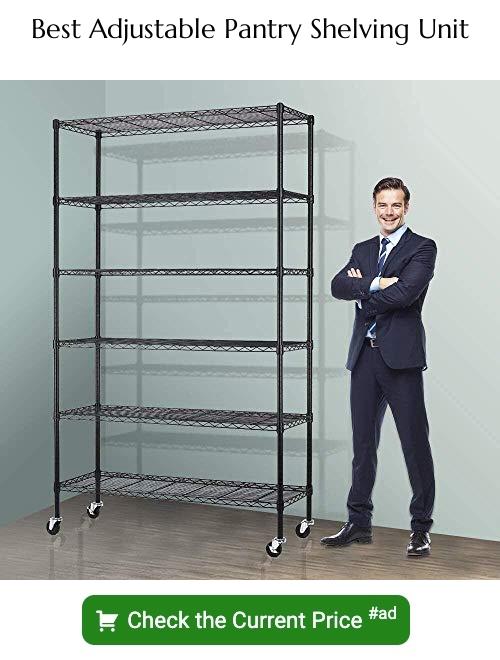Last updated on
Setting your pantry shelving at the right heights can spark a significant enhancement in organization, because it optimizes the space for your unique storage needs.
I’m excited to share this article and unique designs about Pantry Shelving Heights that I’ve created, hoping that you find as much inspiration and joy reading it as I had in making it.
Setting the right heights for pantry shelves can significantly enhance your storage space and overall kitchen functionality. It’s crucial to consider the items you plan to store on each shelf when determining their heights.
A general rule of thumb is to set the heights between 15-20 inches apart for larger items like cereal boxes and small appliances, and around 6-8 inches for smaller items like cans and spices.
However, adjustable shelves offer the most flexibility for changing needs.
Stay tuned to this article for a more detailed guide on pantry shelving heights.
Key takeaways:
- Set pantry shelving heights based on item size and frequency.
- Aim for adjustable shelves for flexibility in changing needs.
- Choose ideal location for pantry shelving based on accessibility and traffic flow.
- Take stock of items in your pantry to determine shelving arrangement.
- Consider material choices and maintenance for pantry shelves.
Select the Ideal Placement for Your Pantry Shelving
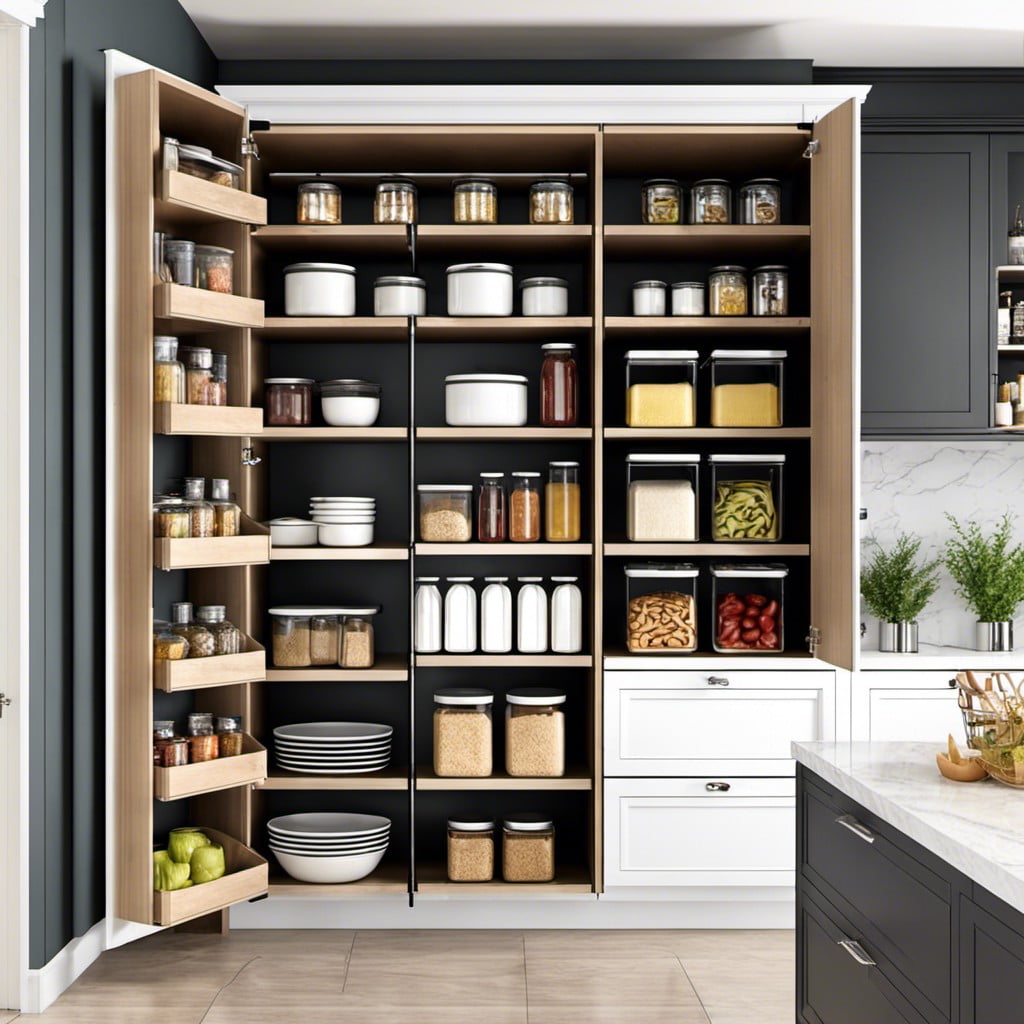
Finding the perfect spot for your pantry shelving is pivotal for storage efficiency. It should ideally be a location that’s easily accessible, yet not disruptive to the overall kitchen flow. Evaluate your kitchen’s layout; walls adjacent to the fridge or close to the prep area often serve well. Avoid spots that block natural light or hamper the use of kitchen appliances.
Here are the considerations:
- Accessibility: How often you use an item should dictate its location. Everyday items require an arm’s length reach while rarely used items can be placed higher or lower.
- Visibility: Light should sufficiently reach all shelves. If not, consider incorporating under-shelf lighting.
- Traffic Flow: A constant rummaging through the pantry during cooking can disrupt meal preparation. Striking a balance between accessibility and convenience is the key.
- Size of the Kitchen: Smaller kitchens might require creative solutions like pull-out cabinets or recessed shelving.
Remember, the goal here is to make your pantry functional and streamlined for your unique needs.
Take Stock of What You Store in Your Pantry
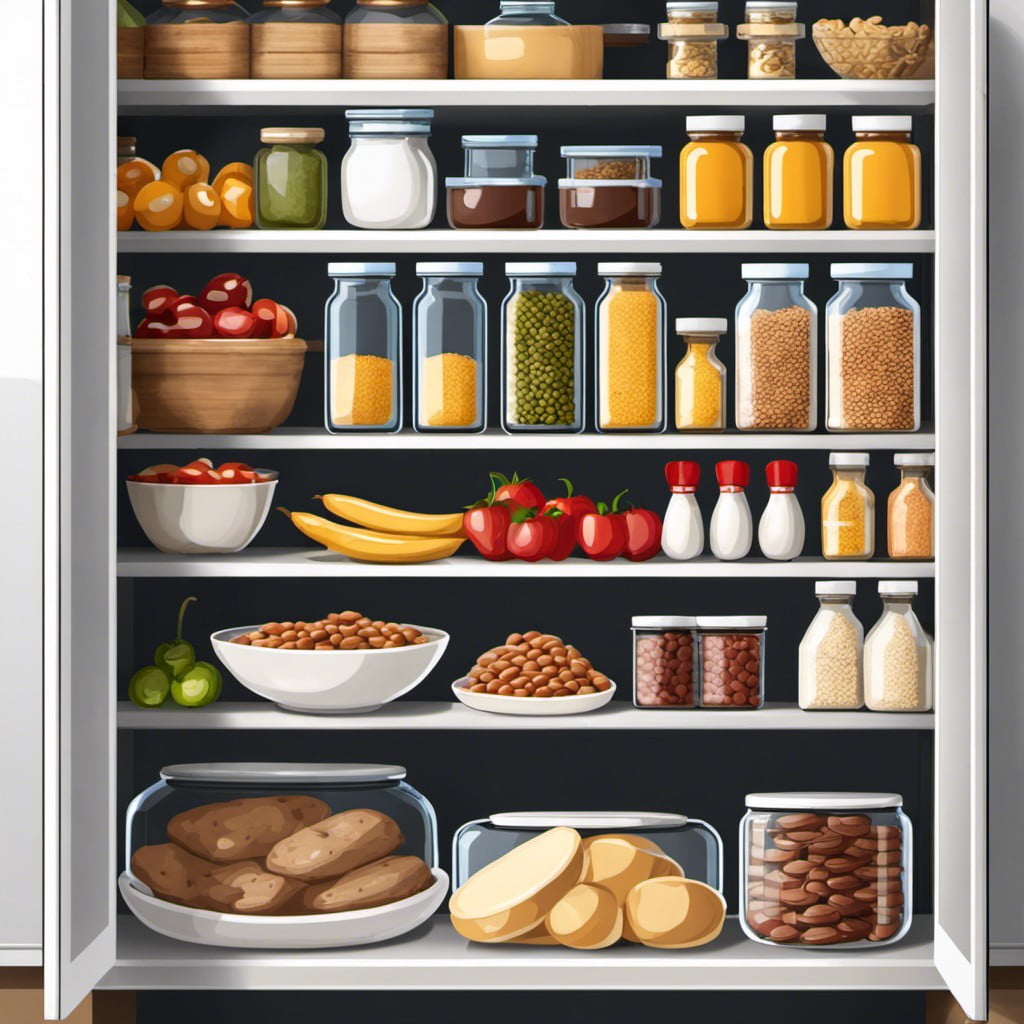
As a significant first step, observe the items regularly stored in your pantry. These ideally dictate the shelving arrangement. Not everything in the pantry is equal—diversity ranges from tall cereal boxes and sizable cooking pots to small spice jars and petite packets of seasoning.
Creating a visual or written inventory can greatly benefit the process. With this enumeration, categorize items based on size and frequency of use. Frequently used items should have easy access, typically at eye-level. Rarely used things might find their home on harder-to-reach, high shelves. Meanwhile, bulky and heavy items are best stowed on lower shelves for safety.
Understanding what you store lets you tailor your pantry’s shelving to your unique needs.
Size and Depth for Walk-In Pantries and Pantry Shelves
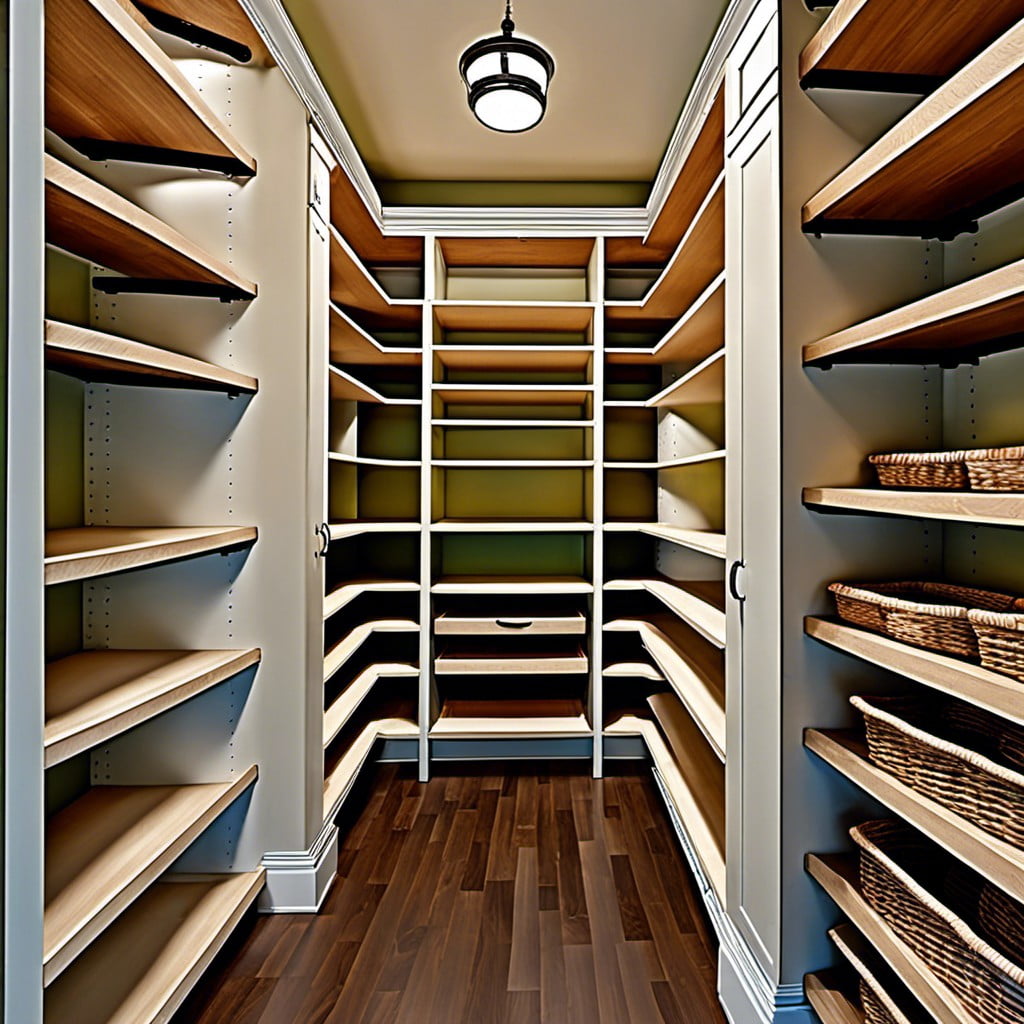
If you’re lucky enough to have a walk-in pantry, the recommended depth for any shelving is 16″ to 20″. This provides ample space for most food storage containers, boxes, and canned goods while keeping everything clearly visible. However, utilizing the full depth isn’t always practical or necessary. Consider a more shallow design for smaller items that can become lost in deep storage.
Non-walk-in pantry shelves should be designed with depth in mind as well. Too deep may waste valuable space, and too shallow might not provide the needed capacity. A depth of 12″ to 16″ generally provides a sufficient balance.
Always factor in the height and overall dimensions of stored items when planning your shelf size, ensuring enough room for larger items like cereal boxes or soda bottles.
Consider Your Shelving Options
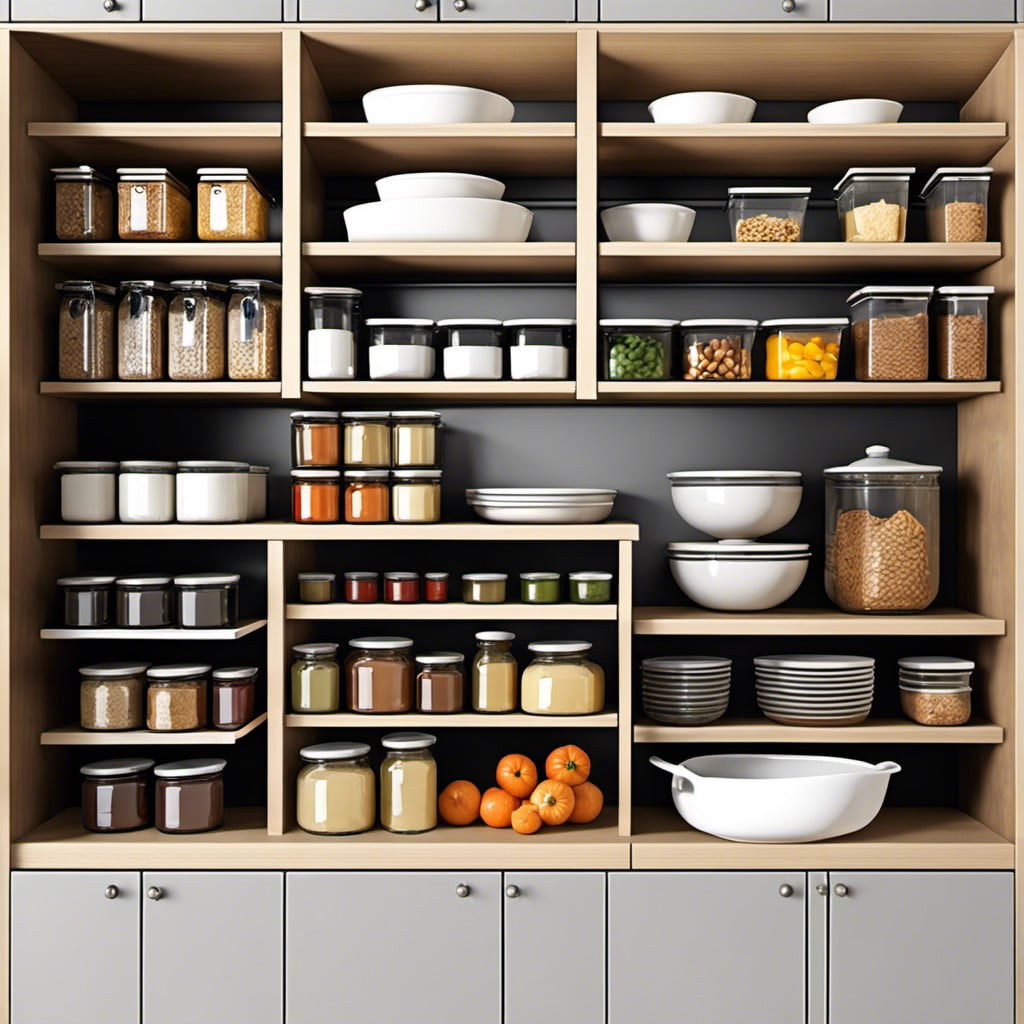
Choosing the right type of shelf plays a substantial role in maximizing storage capacity while maintaining easy access to items. Open shelves, for instance, provide a straightforward view of commodities, ideal for high-demand items. On the other hand, pull-out shelves can be beneficial for heavy or often used items, as they prevent stooping or reaching high overhead.
Adjustable shelving is another feature to consider, offering the flexibility to rearrange the gaps as per the changes in pantry stash. A combination of these options, arranged strategically, can ensure the highest level of functionality and convenience in your pantry.
Ensure Enough Space Between Shelves
To maximize your pantry’s functionality, it’s crucial to ensure there is adequate spacing between your shelves. Consider the most common items you store. For instance, cereals and baking goods tend to require around 12-16 inches of vertical space. Canned goods and spices typically fit well into 6-12 inch tall sections. Meanwhile, bulky appliances or large shop items might need 18 inches or more. A good technique is to have adjustable shelving that can change with your needs. Always remember to leave some extra room for easy access and visibility. This strategic placement ensures optimal utility and flexibility, preserving your pantry’s orderliness and accessibility.
Effective Pantry Shelf Heights
Optimal height between pantry shelves varies based on the items you usually store. For canned goods or small packages like spices, aim for a space of 6 to 8 inches. Larger items such as cereal boxes and cooking equipment necessitate a shelf-height of around 12 to 16 inches. Allocate the highest shelves, 18 to 20 inches, for rarely used or bulk items. It’s important to keep shelf adjustments in mind – having the option to modify the height will offer flexibility as your storage needs change.
Material Choices and Maintenance of Pantry Shelves
Wood and metal rank high in the list of pantry shelf materials due to their durability and versatile aesthetics. Particleboard shelves, while affordable, might sag under significant weight over time, hence requiring regular observation and timely replacements when necessary.
Maintenance relies heavily on the material selected. Wooden shelves, while hearty, may demand regular dusting and occasional polish for maintaining their luster and preventing any pests or rot. On the other hand, metal shelves are resistant to pests and rot but may necessitate occasional repainting to fend off rust. Cleaning these shelves is rather easy – a simple wipe with a damp cloth should suffice.
If opting for wire shelving, small items may fall through or tip over, so consider including shelf liners. These liners not only provide a stable surface but also offer an easy-to-clean aspect to the shelves.
Stainless steel and laminated shelves are another great option for those looking for minimal upkeep. They are easy to clean, resistant to staining, and fairly hardy. Protip – use clear shelf liner on laminated shelves to protect against any possible scratches.
Lastly, it’s beneficial to ensure hardware such as brackets, anchors, or supports are of equal caliber to your chosen shelf material to resist wear and tear whilst maintaining the visual appeal. Always replace any worn-out components promptly to avoid damage to the shelving or stored items.
FAQ
What is a good height for pantry shelves?
A good height for the bottom-most pantry shelf is typically between 20 to 24 inches from the floor, which allows sufficient room for storage of bulk items.
What is standard shelf height?
The standard shelf height ranges from 72 to 78 inches from the floor for standing access, and no more than 60 inches high for sitting access, while the lowest shelf typically sits 3 to 4 inches above the floor.
How wide should a pantry be for shelves on both sides?
For a pantry with shelves on both sides, the minimum width should be 76 inches, or 92 inches for wheelchair access.
What size boards for pantry shelves?
The ideal size for pantry shelves is typically achieved using ¾-inch thick plywood, wood, or MDF boards, in combination with 1-by-2 boards.
What type of material is most suitable for pantry shelves?
Due to its durability and sturdy nature, solid hardwood is the most suitable material for pantry shelves.
What spacing between pantry shelves optimizes storage efficiency?
The optimal spacing between pantry shelves for maximum storage efficiency generally ranges between 10 to 12 inches.
How does pantry shelf depth impact functionality and accessibility?
Pantry shelf depth directly impacts functionality and accessibility by determining the size of items that can be stored and how easily they can be reached; deeper shelves hold larger items but may require more effort to access items at the back.
Recap:
